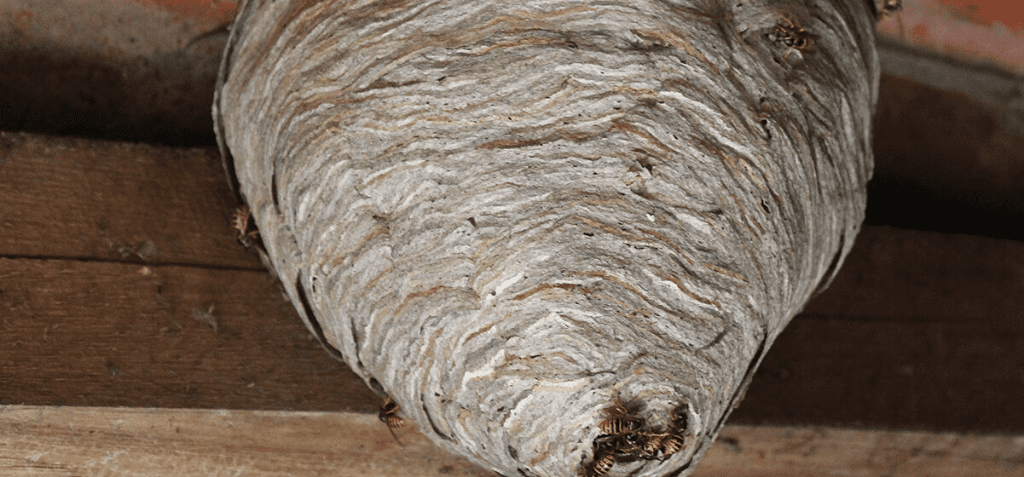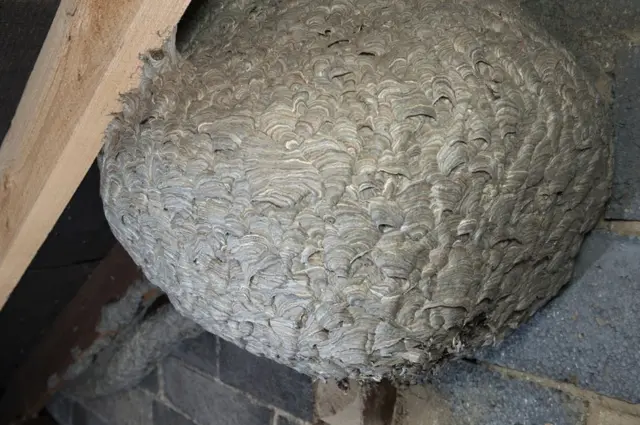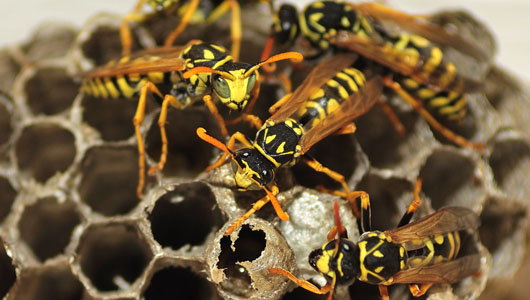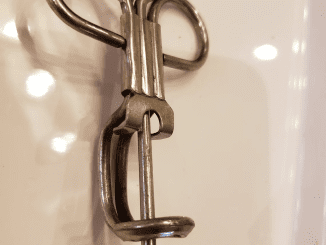If the sight of a wasp makes you nervous, then prepare for an extraordinary story that might just make your skin crawl. Imagine finding an enormous wasp nest in your home, so large it could be considered one of nature’s art pieces—yet horrifying enough to make anyone shudder. This is precisely what one woman in Winchester, Hampshire, UK, experienced when she discovered a nest of approximately 5,000 wasps had taken over her spare room.
This massive infestation is one of the most jaw-dropping cases pest controller John Birkett, who has spent 45 years in the field, had ever seen. Here’s the incredible story of the discovery, removal, and the challenges faced in evicting these uninvited guests.

A Shocking Discovery: The Unwanted House Guests in Winchester
Like many homes, the spare room in this Winchester house was left undisturbed for a while. Little did the homeowner know that she was also leaving it open for a colony of wasps to build a truly enormous nest. By the time she realized something was amiss, the colony had grown into an almost meter-wide structure, over 30 centimeters deep, completely covering a comforter with sentimental value.
The homeowner, understandably horrified by her discovery, immediately contacted John Birkett of Longwood Services, a seasoned pest controller. Birkett, who’s seen his fair share of pest problems, was still taken aback by the size and complexity of the nest, calling it “the most unusual thing” he’d encountered in his long career.
Why Do Wasps Build Nests Indoors?
Wasps typically build nests in protected areas where they feel safe from predators and the elements. While it’s common to find smaller nests in outdoor spaces like porches, sheds, or tree branches, it’s unusual to find a nest of this magnitude indoors.
In this case, the spare room provided a safe, undisturbed space with minimal human traffic. During the warmer months, wasps are particularly active and can expand a nest quite rapidly if undisturbed. The sheer scale of this nest was made possible because the colony had access to food and security, allowing it to grow to this extraordinary size. This phenomenon serves as a reminder to regularly check unused spaces in our homes to prevent such infestations.
The Massive Nest: A Comforter Overrun by 5,000 Wasps
When Birkett arrived, he faced a daunting sight. The nest had engulfed the comforter on the bed, covering it entirely with its complex structure. Birkett recalls the surreal scene and the meticulous planning required to remove the nest without causing wasps to escape into the rest of the house.
The homeowner asked if he could salvage the comforter due to its sentimental value. However, when Birkett attempted to remove it, he described an “explosion of wasps” that poured out from the nest. Each wasp was on high alert, their buzzing filling the air as they sensed an intruder threatening their home.
Handling the Infestation: Safety Measures and Techniques
Removing a nest of this magnitude isn’t a job for the faint-hearted. Equipped with protective clothing and armed with specialized pest spray, Birkett knew he had to act swiftly to control the situation. Opening the door too widely would allow the wasps to swarm into other parts of the house, creating a much larger problem. He had to balance speed with caution, ensuring he avoided both a painful sting and a full-blown infestation in the rest of the home.

Credit / Facebook – John Birkett
In just under an hour, Birkett managed to bring the situation under control, containing the wasps and beginning the careful process of dismantling the nest. The infestation had damaged the mattress and bed pillars, with the wasps chewing through portions of the wood to expand their home. This discovery added to the surreal experience, with Birkett describing the nest as “a wonderful piece of art” that showcased the wasps’ intricate architectural skills.
Mixed Emotions: The Ethical Dilemma of Destroying the Nest
Despite the threat they posed, Birkett couldn’t help but appreciate the beauty of the nest’s structure. “I have mixed feelings about killing the wasps,” he admitted. “You don’t want to kill anything, but you have to do it because they were a pest.” This conflict is common among pest controllers who, despite their appreciation for nature, must often remove or exterminate insects to protect human health and safety.
In this case, there was no other option; leaving the wasps in place would pose too high a risk. Birkett’s reflection highlights a broader ethical conversation in pest control—balancing our respect for nature with our need for safety in shared spaces. It’s a delicate line to walk, especially when faced with something as remarkable as a nest created by thousands of industrious insects.

Why Such Large Nests Are Rare
A nest of this size isn’t something you see every day. Wasps usually begin building their nests in the spring, and these colonies grow throughout the warmer months. However, most wasp colonies don’t reach this scale because they are discovered and dealt with before they become so large. It’s only in unusual cases, such as this unvisited spare room, that wasps have the uninterrupted time to create such massive nests.
In colder climates, wasp colonies generally die off with the arrival of winter, leaving only the queen to start a new colony in the spring. However, in regions with milder winters or insulated indoor spaces, colonies can survive longer, which contributes to the nest’s growth. This Winchester home provided just the right environment for the wasps to thrive undisturbed.
Prevention Tips: How to Keep Wasps Out of Your Home
For homeowners looking to avoid a similar situation, there are a few simple steps you can take to prevent wasp infestations:
- Regularly Inspect Unused Spaces: Basements, attics, garages, and spare rooms should be checked every few weeks, especially in the warmer months. Look for early signs of nest-building and act quickly before they expand.
- Seal Entry Points: Wasps can enter through tiny cracks or holes in walls, windows, and vents. Make sure to seal any openings and repair damaged screens.
- Eliminate Food Sources: Wasps are attracted to sweet foods and water sources. Keep food sealed and ensure that there are no leaks or standing water near your home.
- Use Wasp Repellents: Essential oils like peppermint and eucalyptus can act as natural repellents. You can use these oils around entry points to deter wasps from making your home their own.
- Seek Professional Help Early: If you notice wasps starting to build a nest, contact a pest control professional promptly to prevent a large infestation.

Conclusion: A Cautionary Tale and a Fascinating Discovery
The story of the Winchester woman and her 5,000 uninvited guests is a cautionary tale about the importance of home maintenance and vigilance. While this massive nest presented a unique and unsettling challenge, it also underscored the incredible, often unseen world of insect engineering. For John Birkett, it was a career-defining moment, blending awe with practicality as he dealt with the giant nest.
This tale reminds us of the intricate balance we share with nature, even in our own homes. While pests may need to be removed to ensure our safety, we can still appreciate the artistry in their creations—though hopefully, from a distance!


